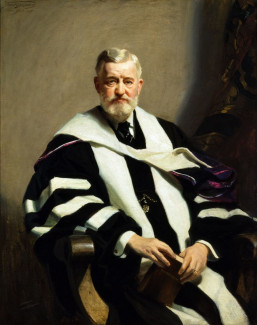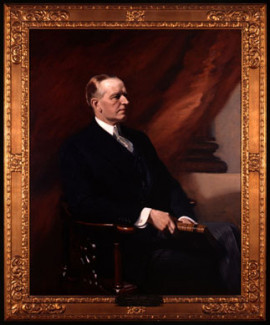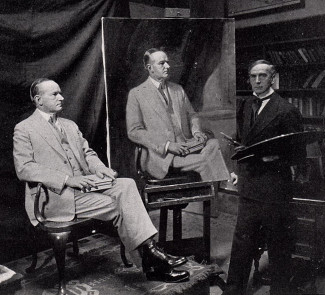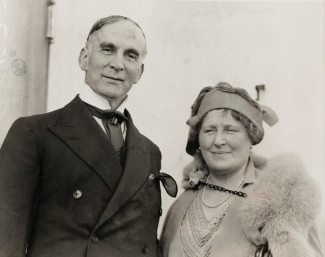
Johns Hopkins UniversityEst. 1876
America’s First Research University
Shakespeare Collector Henry Clay Folger and President Calvin Coolidge

Shakespeare collector Henry Clay Folger and President Calvin Coolidge were 6th cousins, once removed; surely they never knew it. They both graduated with a B. A. degree from Amherst College in Amherst, Massachusetts; Folger in 1879, Coolidge in 1895. They would not have met at college reunions, held every five years, because they were not in the same cycle. They were not in the same college fraternity. They may never have met.

Photo 1: Henry Folger oil portrait by Frank O. Salisbury, 1927, hanging in the reading room at the Folger Shakespeare Library in Washington, D.C.
They each enjoyed the friendship of an Amherst classmate who would become well-known. Henry’s roommate for four years was Charles Millard Pratt, also from Brooklyn, who became vice-president of Standard Oil Company of Kentucky while Henry was president of Standard Oil Company of New York. Calvin’s classmate was Dwight Morrow, attorney at J. P. Morgan and Ambassador to Mexico. After Henry Folger died in 1930, the terms of his will became known whereby the Amherst College trustees would administer the Folger Shakespeare Library in Washington, D.C. When the first chairman of the trustees’ Folger library committee, Dwight Morrow, died in 1931, Calvin Coolidge became the second chairman.

Photo 2: Calvin Coolidge oil portrait by Frank O. Salisbury, 1928. This copy he painted in 1934--commissioned by members of the American Antiquarian society--was hung in the Oval Office at the request of President Ronald Reagan.
It is not generally known that Folger and Coolidge had decided to have their portraits painted by the same artist, the Brit, Frank O. Salisbury. Known as Britain’s “Painter Laureate,” he is responsible for portraits of twenty-five members of the House of Windsor from King George V to Princess Elizabeth. The painter divided his time between England and America, doing very well for himself financially. On the highest hill overlooking London, he built a property called Sarum Chase on Hampstead Heath that sold in 2005 for over £9 million. Folger sat for Salisbury on January 29, 1927 in the painter’s studio in the Waldorf Hotel in New York City. He was delighted when Folger agreed to pose in his colorful academic robe with an Amherst purple hood. Salisbury beseeched Folger to bring something to hold in his hands. He arrived with a small stout book from his collection, the first attempt at a collected edition of Shakespeare’s works called the Pavier quartos, printed in London in 1619. The seventeenth-century book buyer, Edward Gwynn, had stamped his name in gold letters on the original binding. Folger came to the sitting alone by subway, with the precious volume wrapped up in a newspaper.

Photo 3: Photo of Salisbury while painting the Coolidge portrait, 1928 from the painter’s book, Portrait and Pageant, 1944.
Salisbury’s first trip to Washington, D.C. was during a snowy Christmas season in 1928. When Coolidge greeted the painter, he apologized by saying, “There is very little in these days that I can offer you,” for it was the Prohibition era. The artist related in his memoir, “There was a dish of fruit on the table, from which he took an apple and pared it, cutting it in two, and offering me the top half.” Salisbury remarked on how little the president spoke to his guests. During lunchtime, Coolidge directed “most of his conversation to his white collie dog.” The chief executive invited Salisbury to accompany him by special train to Georgia for a stay on Sapelo Island which included a wild turkey hunt at dawn. When the time came for the first sitting, Coolidge appeared in a black suit, “but he looked like a parson.” He agreed to change into a light suit. A photograph taken during the sitting shows Salisbury could not dissimulate an irascible scowl. Having apprenticed in a stained glass factory, the painter came to adore vibrant colors, throwing up his hands in despair in front of a plain suit.

Photo 4: Frank O. and Maude Salisbury on board the S.S. Olympic, 1932.
Stephen H. Grant is a senior fellow at the Association for Diplomatic Studies and Training. He is the author of Collecting Shakespeare: The Story of Henry and Emily Folger and Peter Strickland: New London Shipmaster, Boston Merchant, First Consul to Senegal.


